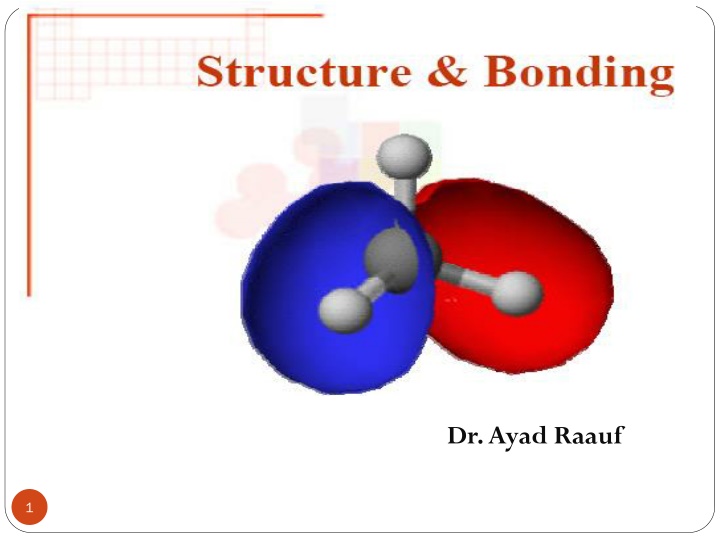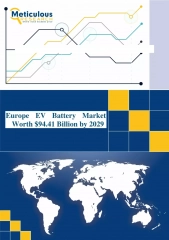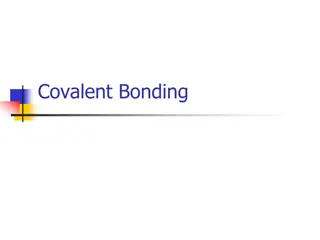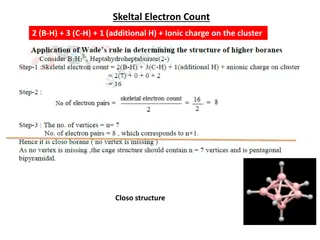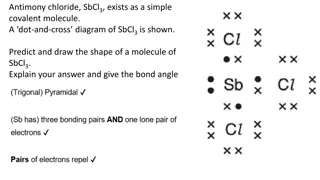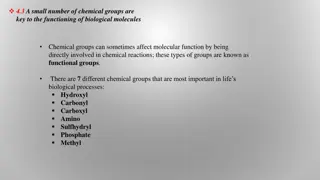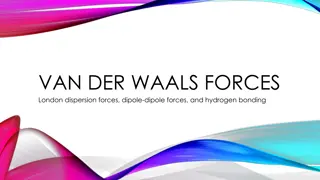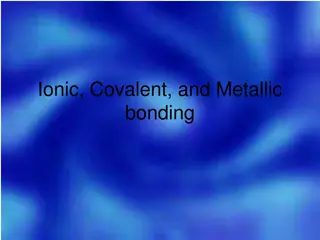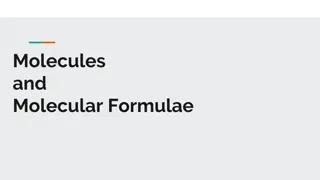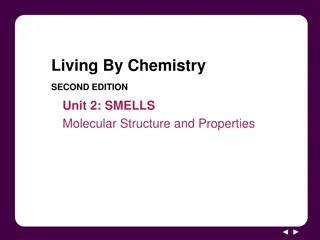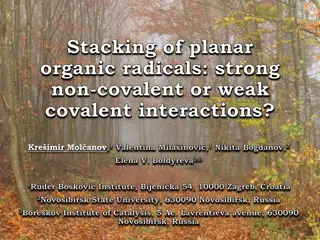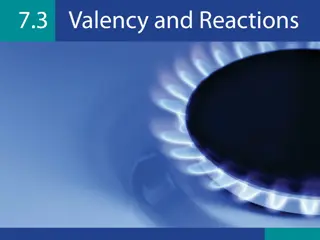Chemical Bonding in Molecules
The structure theory explains how atoms form molecules through chemical bonds. Bonding involves electron transfer or sharing to achieve stability. Different electronegativities determine the type of bonding, whether ionic or covalent. Covalent bonds, formed through orbital overlap, play a crucial role in organic compounds' reactivity and complexity.
Download Presentation

Please find below an Image/Link to download the presentation.
The content on the website is provided AS IS for your information and personal use only. It may not be sold, licensed, or shared on other websites without obtaining consent from the author.If you encounter any issues during the download, it is possible that the publisher has removed the file from their server.
You are allowed to download the files provided on this website for personal or commercial use, subject to the condition that they are used lawfully. All files are the property of their respective owners.
The content on the website is provided AS IS for your information and personal use only. It may not be sold, licensed, or shared on other websites without obtaining consent from the author.
E N D
Presentation Transcript
Structure and bonding The structure theory is the framework of ideas about how atoms are put together to make molecules. The structure theory has to do with the order in which atoms are attached to each other, and with the electrons that hold them together. Any consideration of the structure of the molecules must begin with the discussion of chemical bonds, the forces that hold atoms together in a molecule. 2
Bonding between atoms involves the transfer, or sharing, of electron density such that each atom is left with a stable outer shell of electrons. For atoms with significantly different electronegativity (is the ability of an atom that is bonded to another atom or atoms to attract electrons strongly towards it). The process of "bonding" generally involves complete electron transfer to form two species having net positive and negative charges. This type of bonding is termed ionic and simple salts are the classic examples (the electro negativities of sodium and chlorine are 0.93 and 3.16, respectively) Na+Cl - 3
Atoms with similar or identical electronegativities, bonding involves the sharing of two electrons, one from each atom and this describe as a single bond (single line), in a type of bonding which is termed covalent. Covalent bond, it is possible to identify whether it is a polar or nonpolar bond. In general, most bonds within organic molecules, including various drug molecules, are covalent. 4
Nonpolar covalent bond, the electrons are shared equally between two atoms, e.g. H-H and F-F. Polar covalent bond, one atom has a greater attraction for the electrons than the other atom). For example(CH3Cl), carbon and chlorine have electro negativities of 2.55 and 3.96, respectively. These values are close enough that the carbon-chlorine bond is covalent, but the bond is not symmetrical and the bulk of the electron density is associated with the more electronegative chlorine. This polarization leaves a partial positive charge ( +) on the carbon and a matching partial negative charge ( -) on the chlorine. It is this polarization which gives organic compounds their chemical reactivity and allows simple structural units to be combined to form more complex molecules, i.e., the science of organic 5
Covalent bonds are formed when atomic orbitals overlap. Electrons surrounding atoms are concentrated into regions of space called atomic orbitals. The electronic configuration of carbon is 1s2 2s2 2p2. Atomic s orbital is spherical in shape and p orbital are in dumbbell shape which are shown below. 6
The sharing of electrons in a covalent bond occurs by overlap of the individual atomic orbitals. Head-on overlap between energetically compatible orbitals generates sigma ( ) bonds. while sideways overlap (typically from adjacent p orbitals) generates pi ( ) bonds. In molecular orbital theory, the number of atomic orbitals used to make the covalent bond The nature of the bonding in hydrogen (H2) can be described using Molecular Orbital Theory. 7
The orbital description of carbon, being 1s2 2s2 2p2, would suggest that, in order to form four bonds, a 2s electron must be promoted to the empty p-orbital to provide an electronic structure as shown below: One s plus three p = four orbital; so must get four hybrids orbital: 4 sp3 orbitals. Shape of sp3: Overlap of s and p orbital -------> changed shape 8
Carbon forms four bonds and the simplest hydrocarbon (methane) has a molecular formula of CH4. The arrangement of these atoms in space, however, is not immediately apparent, and at least three possibilities should be considered: square planar, in which the four hydrogens occupy the corners of a square, centered about the carbon. pyramidal, in which the carbon and three hydrogens occupy a plane with carbon in the middle and hydrogens at the vertices of a triangle. tetrahedral, in which the carbon is in the center of a regular tetrahedron and hydrogens are at each vertex. The methane has bond angles 109 , and the four C-H bonds are all equivalent and identical in reactivity, so, the methane is tetrahedral in shape. 9
Two additional orbital hybrids are also available for carbon: sp2 Hybridization: One in which the 2s-orbital combines with two of the available p-orbital (sp2). The geometry predicted for the sp2 hybrid is trigonal with the unused p-orbital perpendicular to the plane. Carbons which are sp2 must be connected to at least one additional sp2 atom and organic molecules containing one or more pairs of sp2 carbons are called alkenes. A model for the simplest alkene, ethene (CH2=CH2) is shown below. 10
sp Hybridization: Mixing of one 2s orbital with one 2p orbital gives two identical sp hybrid orbitals. Since they are identical, their uniform distribution in space is achieved by localization along a single axis with central C atom (180o valence angle). The two remaining orbitals are capable of forming two orbitals with the analogous orbitals of adjacent atoms (e.g. sp hybridized carbon). This will give rise to a triple bond consisting of a single bond and two mutually orthogonal -bonds. This situation is represented by acetylenes. The geometrical consequence of the sp hybridization is the linearity of the structure. 11
The three types of hybridization which are encountered in carbon compounds are shown below for the molecules ethane (sp3, an alkane), ethene (sp2, an alkene) and ethyne (sp, an alkyne) 12
Double bonds, whether they be C=C, C=O, or C=N. If you have two or more double bonds in the same molecule, depending upon whether are isolated or conjugated. Conjugated an arrangement in which double bonds are separated by a single bond. C H2 CH3 CH2 H2 C 1,3-pentadiene 1,4-pentadiene conjugated double bond isolated double bond H H H C H2 C C H2 C C H2 C C H2 C CH2 C CH C N C NR C H H H H conjugated diene conjugated ene-yne conjugated nitrile conjugated imine H H . H H C H2 C - C + C H2 C H2 C C H2 C O C C C C H H H H H H H conjugated carbonyl conjugated carbocation conjugated carboanion conjugated radical 13
Vitamin A1(retinol) is derived in mammals by oxidative metabolism of plant derived dietary carotenoids in the liver, especially -carotene. CH3 CH3 H3 C CH3 CH3 CH3 CH3 H3 C CH3 H3 C - carotene O2 cleavage of central double bond generate two molecules of retinal CH3 H3 C CH3 CH3 CH3 H3 C CH3 CH3 NADH OH O CH3 CH3 retinal reduction of aldehyde to alcohol retinol (vitamin A1) NADH = Nicotinamide adenine dinucleotide dehydrogenises 14
Resonance is a way of describing delocalized electrons within certain molecules or polyatomic ions where the bonding cannot be expressed by one single Lewis formula. A molecule or ion with such delocalized electrons is represented by several contributing structures (also called resonance structures ). 15
Conjugation, Resonance, and Dienes Electrophilic Addition: 1,2- Versus 1,4-Addition The bonds in conjugated dienes undergo addition reactions that differ in two ways from the addition reactions of isolated double bonds. 1. Electrophilic addition in conjugated dienes gives a mixture of products. 2. Conjugated dienes undergo a unique addition reaction not seen in alkenes or isolated dienes. Recall that electrophilic addition of one equivalent of HBr to an isolated diene yields one product and Markovnikov s rule is followed. 16
Conjugation, Resonance, and Dienes Electrophilic Addition: 1,2- Versus 1,4-Addition With a conjugated diene, electrophilic addition of one equivalent of HBr affords two products. The 1,2-addition product results from Markovnikov addition of HBr across two adjacent carbon atoms (C1 and C2) of the diene. The 1,4-addition product results from addition of HBr to the two end carbons (C1 and C4) of the diene. 1,4-Addition is also called conjugate addition. The ends of the 1,3-diene are called C1 and C4 arbitrarily, without regard to IUPAC numbering. 17
Conjugation, Resonance, and Dienes Electrophilic Addition: 1,2- Versus 1,4-Addition Addition of HX to a conjugated diene forms 1,2- and 1,4-products because of the resonance-stabilized allylic carbocation intermediate. 18
Bond polarity is a useful concept for describing the sharing of electrons between atoms. Thus, bond polarity arises from the difference in electronegativities of two atoms participating in the bond formation. This also depends on the attraction forces between molecules, and these interactions are called intermolecular interactions or forces. There are three types of nonbonding intermolecular interaction: dipole dipole interactions vander Waals forces hydrogen bonding. These interactions increase significantly as the molecular weights increase, and also increase with increasing polarity of the molecules. 19
Dipoledipole interactions are electrostatic interactions of permanent dipoles in molecules. These interactions tend to align the molecules to increase the attraction. An example of a dipole dipole interaction can be seen in hydrogen chloride (HCl): The positive end of a polar molecule will attract the negative end of the other molecule and cause them to be arranged in a specific arrangement. Polar molecules have a net attraction between them. For example HCl 20
Relatively weak forces of attraction that exist between nonpolar molecules are called van der Waals forces or London dispersion forces. van der Waals forces are the weakest of all the intermolecular interactions. The greater the area of contact, the stronger are the van der Waals forces For example, isobutane (b.p.-10.2 C) and butane (b.p. 0.6 C), both with the molecular formula C4H10, have different boiling points. Isobutane is a more compact molecule than butane. Thus, butane molecules have a greater surface area for interaction with each other than isobutane. 21
Hydrogen bonding is the attractive force between the hydrogen attached to an electronegative atom of one molecule and an electronegative atom of the same (intramolecular) or a different molecule (intermolecular). It is an unusually strong force of attraction between highly polar molecules in which hydrogen is covalently bonded to nitrogen, oxygen or fluorine. 22
